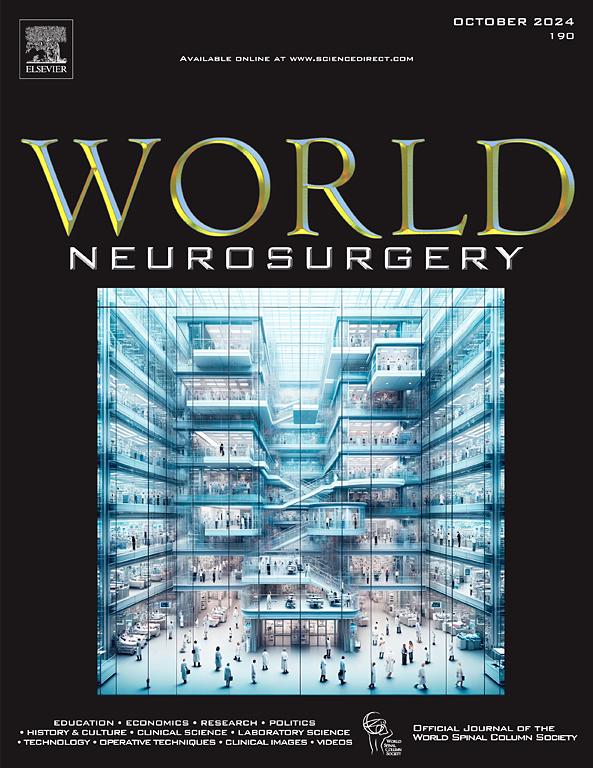基于SHAP预测后路腰椎融合术后手术部位感染的可解释机器学习模型。
IF 1.9
4区 医学
Q3 CLINICAL NEUROLOGY
引用次数: 0
摘要
研究设计:回顾性研究目的:本研究旨在建立机器学习(ML)模型,并结合一种可解释的方法来预测后路腰椎融合术后手术部位感染(SSI)。方法:在这项回顾性的单中心研究中,共纳入1016例连续行后路腰椎融合手术的患者。建立了一个全面的数据集,包括人口统计学变量、合并症、术前评估、与诊断腰椎疾病相关的细节、术前实验室检查、手术细节和术后因素。利用该数据集,开发了6个ML模型来预测SSI的发生。模型在测试集上的性能评估涉及几个指标,包括受试者工作特征(ROC)曲线、曲线下面积(AUC)、准确率、召回率、f1评分和精度。采用Shapley加性解释(SHAP)方法生成可解释的预测,从而能够对SSI风险进行全面评估,并对模型结果提供个性化的解释。结果:纳入研究的1016例回顾性病例中,36例(3.54%)发生SSI。在测试的六个模型中,XGBoost模型在测试集中表现出最高的歧视性性能,实现了以下指标:精度(0.9000),召回率(0.8182),准确度(0.9902),F1分数(0.8571)和AUC(0.9447)。利用SHAP方法,确定了SSI的几个重要预测因素,包括颈静脉导管留置时间、Bun水平、总蛋白水平、持续发热、Cr水平、甘油三酯水平、单核细胞计数、糖尿病、引流时间、白细胞计数、脑梗死、估计失血量、白蛋白前水平、预后营养指数、腰痛、PF评分和骨质疏松症。结论:基于ml的预测工具可以准确评估后路腰椎融合术后SSI的风险。此外,ML结合SHAP可以对个体化风险预测提供清晰的解释,并使医生直观地理解模型基本特征的影响。本文章由计算机程序翻译,如有差异,请以英文原文为准。
Explainable Machine Learning Models for Prediction of Surgical Site Infection After Posterior Lumbar Fusion Surgery Based on Shapley Additive Explanations
Objective
This study aims to develop machine learning (ML) models combined with an explainable method for the prediction of surgical site infection (SSI) after posterior lumbar fusion surgery.
Methods
In this retrospective, single-center study, a total of 1016 consecutive patients who underwent posterior lumbar fusion surgery were included. A comprehensive dataset was established, encompassing demographic variables, comorbidities, preoperative evaluation, details related to diagnosed lumbar disease, preoperative laboratory tests, surgical specifics, and postoperative factors. Utilizing this dataset, 6nullML models were developed to predict the occurrence of SSI. Performance evaluation of the models on the testing set involved several metrics, including the receiver operating characteristic curve, the area under the receiver operating characteristic curve, accuracy, recall, F1 score, and precision. The Shapley Additive Explanations (SHAP) method was employed to generate interpretable predictions, enabling a comprehensive assessment of SSI risk and providing individualized interpretations of the model results.
Results
Among the 1016 retrospective cases included in the study, 36 (3.54%) experienced SSI. Out of the six models examined, the Extreme Gradient Boost model demonstrated the highest discriminatory performance on the testing set, achieving the following metrics: precision (0.9000), recall (0.8182), accuracy (0.9902), F1 score (0.8571), and area under the receiver operating characteristic curve (0.9447). By utilizing the SHAP method, several important predictors of SSI were identified, including the duration of indwelling jugular vein catheter, blood urea nitrogen levels, total protein levels, sustained fever, creatinine levels, triglycerides levels, monocyte count, diabetes mellitus, drainage time, white blood cell count, cerebral infarction, estimated blood loss, prealbumin levels, Prognostic Nutritional Index, low back pain, posterior fusion score, and osteoporosis.
Conclusions
ML-based prediction tools can accurately assess the risk of SSI after posterior lumbar fusion surgery. Additionally, ML combined with SHAP could provide a clear interpretation of individualized risk prediction and give physicians an intuitive comprehension of the effects of the model's essential features.
求助全文
通过发布文献求助,成功后即可免费获取论文全文。
去求助
来源期刊

World neurosurgery
CLINICAL NEUROLOGY-SURGERY
CiteScore
3.90
自引率
15.00%
发文量
1765
审稿时长
47 days
期刊介绍:
World Neurosurgery has an open access mirror journal World Neurosurgery: X, sharing the same aims and scope, editorial team, submission system and rigorous peer review.
The journal''s mission is to:
-To provide a first-class international forum and a 2-way conduit for dialogue that is relevant to neurosurgeons and providers who care for neurosurgery patients. The categories of the exchanged information include clinical and basic science, as well as global information that provide social, political, educational, economic, cultural or societal insights and knowledge that are of significance and relevance to worldwide neurosurgery patient care.
-To act as a primary intellectual catalyst for the stimulation of creativity, the creation of new knowledge, and the enhancement of quality neurosurgical care worldwide.
-To provide a forum for communication that enriches the lives of all neurosurgeons and their colleagues; and, in so doing, enriches the lives of their patients.
Topics to be addressed in World Neurosurgery include: EDUCATION, ECONOMICS, RESEARCH, POLITICS, HISTORY, CULTURE, CLINICAL SCIENCE, LABORATORY SCIENCE, TECHNOLOGY, OPERATIVE TECHNIQUES, CLINICAL IMAGES, VIDEOS
 求助内容:
求助内容: 应助结果提醒方式:
应助结果提醒方式:


